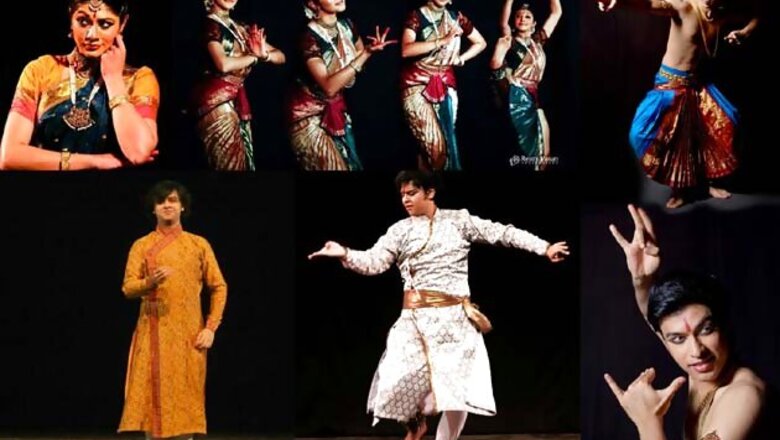
views
Naach, Nritya, Natya Shastra. Three words that may appear same for a commoner, but aren't the same. These words are like a trained asset, like the most precious jewel in a treasure temple and a living organ in any dancer's body.
With the world celebrating The International Dance Day, three young classical artists give their take on experiments with the art, their signature styles as performers, and also answer a pertinent question- has the Indian classical dance form earned an international status in today's time?
If one asks the same set of questions to Revanta Sarabhai, a London based independent choreographer, performer and the grandchild of renowned classical artist Padma Bhushan awardee Mrinalini Sarabhai, he says, "I love experimenting, and talking about my individual style as a male dancer." Revanta never stops his heart from mixing western contemporary moves with the traditional classic flavour and bring it on the dance floor. "Apart from enjoying the new vocabulary of movements, as a modern day classical artist, I really believe it is very important to package and present the art form well and make it accessible to the young audience," says Revanta.
The 28 year old, who holds an MA in Performance and Creative Research from the Roehampton University has not only been trained extensively both in Bharatnatyam and Kuchipudi, but is also known for creating work that has been showcased at several prestigious venues and festivals across Europe, Asia, France and North America. Having performed so voraciously in countries outside India, Revanta states that an as Indian artist it is very fulfilling to see the growth of 'our classical art' worldwide and in today's day the rich form has certainly attained an International status and is fast gaining popularity.
So then, why is the Gen next, the young, restless, impatient and creative mind still not so inclined towards this rich heritage?
"It is not the reality anymore," clarifies Revanta, "In the last three years, the Sarabhai's Ahmedabad based Darpana Academy of Performing Arts has organised a week long festival named 'Celebrating the world of Dance', and has each time being overwhelmed particularly by the young dancers. Be it participation or applause, the festival was a huge hit among the youngsters and still is." A believer of continuous creative innovation, a self claimed workaholic, and a passionate soul Revanata, who is the third Sarabhai generation to take up dance says, he has a lot of dance left in him and in the world to explore and will continue working to keep the legacy and the 'creative being within him' going.
From an independent, liberal modern day male dancer to the feminine Bharatnatyam prodigy in her early twenties, Dakshina Vaidyanathan states that not only Indian classical dance is gaining an International prominence but the youth too is getting connected to it with time.
"As a person of today's evolving time, I would firstly like to put forward honest facts and then talk about my perceptions as an artist. Youth connects to Bharatnatyam as much as to other dance forms, and I think organisations and Councils like Spic Macay, and Indian Council for Cultural relations (ICCR) is really to be taken a note off for their great work. Not only for propagating dance but also for introducing our rich heritage to the youngsters of the country," says the granddaughter of Padma Bhushan awardee Saroja Vaidyanathan.
The curator of a self evolved contemporary style named, 'Neo-classical', Dakshina, who has been trained thoroughly in Bharatnatyam, feels 'an artist can carve his/her own definition by experimenting with the traditional form but it is very essential to have a deep rooted knowledge about the basics'. Ask the B. Tech graduate from VIT Vellore what is most challenging as a 2013 classical dancer? The answer comes prompt and fast. "It is to promote and prove your individual caliber. Creating an unique reason to be known and to be wanted again and again. The day that is achieved, one can say it is the start."
Amidst of such heavy classical independent taste and the talks of charming creative freedom, is the voice of a rather religious conventional art propagator. Pt. Birju Maharaj's grandson and a recipient of the third generation of the Maharaj Parampara is Tribhuvan Maharaj.
Tribhuvan who started dancing from an early age of three says, "My heart cries to say that at an international level even today, the popularity and demand of Indian classical dance of our country is not that pronounced. And till the time the youngsters of our soil take the responsibility to explore and know more about it, possibilities seem very bleak to me." A trained performer of the Lucknow Gharana, the 22 year old however maintains that, 'when it comes to him performing live on stage there is no experimentation or fusion', keeping the essence of Kathak absolutely intact and untouched.
Also, talking about his flexible relationship as a shishya with his grandfather, the young lad concludes by saying, "I have traveled a long way in the journey as a dancer, and my greatest blessing has been that I am born as Maharaj ji's grandson. Apart from training myself as a capable disciple and promoting my art, I want to write a book on Kathak and dedicate it to the world of classical art.
[Photo credits for Revanta Sarabhai's profile: Ashok Jani]


















Comments
0 comment